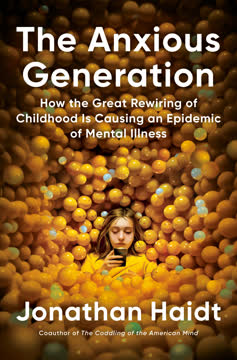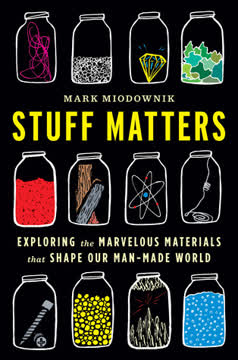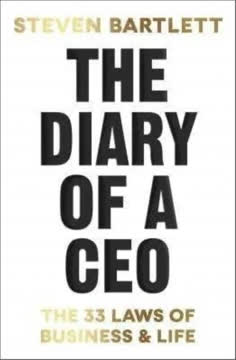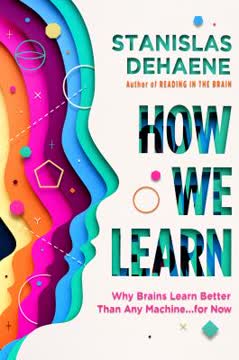نکات کلیدی
1. درک ساختار حافظه انسانی
حافظه کاری محل آگاهی است، بخشی از حافظه که تمام تفکر در آن انجام میشود. برخلاف محیط و حافظه بلندمدت، ظرفیت حافظه کاری محدود به حدود چهار تا هفت «عنصر» اطلاعاتی است.
حافظه به عنوان یک سیستم پیچیده. حافظه انسانی از سه جزء کلیدی تشکیل شده است: محیط (اطلاعات خارجی نامحدود)، حافظه بلندمدت (ذخیرهسازی داخلی نامحدود) و حافظه کاری (فضای تفکر محدود). این ساختار توضیح میدهد که چرا ما دچار بار شناختی میشویم و در پردازش اطلاعات پیچیده با مشکل مواجه میشویم.
تقسیمبندی و خودکارسازی. مغز ما با تبدیل عناصر فردی به تکههای بزرگتر و جامعتر، حافظه کاری محدود را مدیریت میکند. این فرآیند به متخصصان اجازه میدهد تا اطلاعات پیچیده را به طور مؤثرتری نسبت به مبتدیان پردازش کنند. به عنوان مثال، یک استاد شطرنج میتواند به سرعت پیکربندیهای صفحه را شناسایی کند، در حالی که یک مبتدی باید به طور دقیق حرکتهای ممکن هر قطعه را تحلیل کند.
پیامدهای عملی. درک ساختار حافظه به معلمان و یادگیرندگان کمک میکند تا استراتژیهای یادگیری مؤثرتری طراحی کنند:
- اطلاعات پیچیده را به تکههای کوچکتر و قابل مدیریت تقسیم کنید
- به دانشآموزان کمک کنید تا از طریق تمرین مکرر خودکارسازی را توسعه دهند
- درک کنید که اطلاعات جدید به تلاش شناختی بیشتری نیاز دارد
- مواد آموزشی را طراحی کنید که به محدودیتهای حافظه کاری احترام بگذارد
2. دانش اولیه بیولوژیکی در مقابل دانش ثانویه
مؤسسات آموزشی به دلیل نیاز ما به کسب دانش اطلاعات ثانویه بیولوژیکی اختراع شدند.
طبقهبندی دانش. نظریه بار شناختی بین دانش اولیه بیولوژیکی (مهارتهای تکاملیافته مانند زبان و تعامل اجتماعی) و دانش ثانویه بیولوژیکی (مهارتهای آکادمیک و فرهنگی آموختهشده) تمایز قائل میشود. این تمایز به درک چگونگی وقوع انواع مختلف یادگیری کمک میکند.
مکانیسمهای یادگیری. دانش اولیه بیولوژیکی به طور ناخودآگاه و بدون زحمت به دست میآید، در حالی که دانش ثانویه بیولوژیکی به آموزش و تمرین عمدی نیاز دارد. به عنوان مثال، صحبت کردن به زبان مادری به طور طبیعی اتفاق میافتد، اما یادگیری معادلات ریاضی نیاز به تدریس ساختاریافته و تکرار دارد.
پیامدهای آموزشی:
- تفاوت بین مهارتهای ذاتی و آموختهشده را شناسایی کنید
- استراتژیهای آموزشی هدفمند برای دانش ثانویه طراحی کنید
- درک کنید که همه مهارتها نمیتوانند به طور مستقیم آموزش داده شوند
- بر ایجاد محیطهای یادگیری مؤثر برای مهارتهای پیچیده تمرکز کنید
3. مدیریت بار شناختی از طریق بار ذاتی و اضافی
بار شناختی کلی که یک یادگیرنده تجربه میکند ترکیبی از بار ذاتی و بار اضافی است. به عبارت دیگر، بار ذاتی و بار اضافی ترکیبشده نمیتوانند از ظرفیت حافظه کاری فراتر بروند اگر یادگیری قرار است اتفاق بیفتد.
انواع بار شناختی. بار ذاتی به پیچیدگی ذاتی ماده یادگیری مربوط میشود، در حالی که بار اضافی ناشی از نحوه ارائه اطلاعات است. یادگیری مؤثر زمانی اتفاق میافتد که بار اضافی به حداقل برسد و بار ذاتی بهینه شود.
طراحی آموزشی استراتژیک. معلمان میتوانند بار شناختی را با:
- حذف اطلاعات غیرضروری
- سادهسازی توضیحات پیچیده
- ارائه آموزش واضح و متمرکز
- ترتیبدهی مناسب محتوا
- استفاده از مثالهای کارشده و تکنیکهای پشتیبانی مدیریت کنند
تعادل منابع شناختی. هدف این است که اطمینان حاصل شود که حافظه کاری دانشآموزان به طور کامل با محتوای یادگیری ضروری درگیر است و نه با حواسپرتیهای شناختی غیرضروری.
4. تخصص خاص حوزه بر مهارتهای عمومی برتری دارد
در هر حوزه ثانویه بیولوژیکی، میتوانیم انتظار داشته باشیم که تفاوت عمده، شاید تنها تفاوت بین مبتدیان و متخصصان، دانش متفاوتی باشد که در حافظه بلندمدت نگهداری میشود.
توسعه تخصص. برخلاف باور عمومی، مهارتهای عمومی مانند «حل مسئله» نمیتوانند به طور جهانی آموزش داده شوند. تخصص خاص حوزه است و از طریق انباشت دانش تخصصی و جفتهای موقعیت-عمل در یک زمینه خاص توسعه مییابد.
انباشت دانش. متخصصان از مبتدیان نه به دلیل تفکر پیچیدهتر، بلکه به دلیل داشتن دانش سازمانیافته و گستردهتر در حوزه خاص خود متفاوت هستند. به عنوان مثال، یک استاد شطرنج بیشتر از اینکه حرکات بیشتری را محاسبه کند، به سرعت پیکربندیهای آشنا را شناسایی میکند.
استراتژی یادگیری:
- بر دانش عمیق حوزه تمرکز کنید
- حافظه گستردهای از موقعیت-عمل بسازید
- در زمینههای خاص تمرین کنید
- درک کنید که انتقال بین حوزهها محدود است
5. تعامل عناصر تعیینکننده دشواری یادگیری است
هرچه تعداد عناصری که یک دانشآموز باید در حین یک وظیفه یادگیری به آنها فکر کند بیشتر باشد و روابط بین این عناصر پیچیدهتر باشد – تعداد تعاملات – وظیفه یادگیری چالشبرانگیزتر خواهد بود.
پیچیدگی شناختی. دشواری یادگیری به تعداد عناصر در حال تعامل در یک وظیفه و دانش قبلی یادگیرنده بستگی دارد. تعامل بالای عناصر میتواند حافظه کاری را تحت فشار قرار دهد، در حالی که تعامل پایین اجازه پردازش آسانتر را میدهد.
استراتژیهای آموزشی:
- تعداد عناصر در حال تعامل در یک وظیفه را ارزیابی کنید
- یادگیری را به گونهای ترتیب دهید که پیچیدگی عناصر مدیریت شود
- برای وظایف با پیچیدگی بالا پشتیبانی فراهم کنید
- سطوح دانش قبلی دانشآموزان را در نظر بگیرید
- وظایف پیچیده را به اجزای قابل مدیریت تقسیم کنید
یادگیری تطبیقی. تعامل عناصر پویا است و به پیچیدگی ذاتی وظیفه و دانش موجود یادگیرنده بستگی دارد.
6. پیشآموزش بار شناختی را کاهش میدهد
اگر دانشآموزان در هنگام نیاز به فکر کردن درباره تعداد زیادی از عناصر جدید اطلاعات در یک زمان بار شناختی بالایی را تجربه کنند، میتوانیم با پیشآموزش بار شناختی وظیفه کلی را کاهش دهیم.
یادگیری پیشبینیکننده. پیشآموزش شامل معرفی مفاهیم کلیدی، واژگان یا مهارتها قبل از فعالیت یادگیری اصلی است. این رویکرد بار شناختی را با آشنا کردن دانشآموزان با پیچیدگیهای احتمالی کاهش میدهد.
تکنیکهای پیشآموزش:
- واژگان را از قبل معرفی کنید
- نقشههای شخصیت یا زمانبندی ایجاد کنید
- مهارتهای بنیادی را به طور جداگانه آموزش دهید
- دانش قبلی را فعال کنید
- قبل از وظایف پیچیده زمینه را فراهم کنید
مدیریت بار شناختی. با کاهش تعداد عناصر جدید در حین وظیفه یادگیری اصلی، دانشآموزان میتوانند به طور مؤثرتری بر اهداف یادگیری اصلی تمرکز کنند.
7. تقسیمبندی وظایف پیچیده را به تکههای قابل مدیریت تقسیم میکند
برای یادگیرندگانی که دانش قبلی کمی دارند، مزایای قابل توجهی در ارائه رویکرد تقسیمبندی وجود دارد، جایی که بار ذاتی به طور قابل توجهی با ارائه ابتدا یک وظیفه با سطح پایینتری از تعامل عناصر و سپس یک وظیفه کاملتر با سطوح بالاتر تعامل عناصر کاهش مییابد.
تجزیه وظیفه. مهارتهای پیچیده میتوانند به طور مؤثرتری با تقسیم آنها به اجزای کوچکتر و قابل مدیریت یاد گرفته شوند. این رویکرد به یادگیرندگان اجازه میدهد تا عناصر فردی را قبل از ادغام آنها در یک مهارت جامع تسلط یابند.
استراتژیهای تقسیمبندی:
- سلسلهمراتب مهارتها را ایجاد کنید
- از رویکردهای جزء-کل یا کل-جزء استفاده کنید
- اجزای فردی را تمرین کنید
- به تدریج پیچیدگی وظیفه را افزایش دهید
- تجربیات یادگیری پشتیبانیشده فراهم کنید
ساخت مهارتهای تدریجی. تقسیمبندی به این نکته اشاره دارد که یادگیری تدریجی است و نیاز به توسعه سیستماتیک مهارتها دارد.
آخرین بهروزرسانی::
FAQ
What's "Sweller's Cognitive Load Theory in Action" about?
- Overview: "Sweller's Cognitive Load Theory in Action" by Oliver Lovell explores how Cognitive Load Theory (CLT) can be applied in educational settings to enhance teaching and learning.
- Purpose: The book aims to bridge the gap between educational research and classroom practice by providing actionable strategies for teachers.
- Structure: It is divided into three parts: understanding the theory, optimizing intrinsic load, and reducing extraneous load, with practical examples throughout.
- Audience: The book is intended for educators, school leaders, and anyone interested in improving instructional methods based on cognitive science.
Why should I read "Sweller's Cognitive Load Theory in Action"?
- Practical Application: The book offers practical strategies for applying Cognitive Load Theory in the classroom, making it a valuable resource for teachers.
- Research-Based: It is grounded in extensive research and includes insights from John Sweller, the originator of CLT, ensuring the content is both credible and authoritative.
- Improves Teaching: By understanding and applying CLT, educators can enhance their teaching effectiveness and improve student learning outcomes.
- Accessible Language: Oliver Lovell distills complex concepts into understandable language, making the book accessible to educators without a background in cognitive science.
What are the key takeaways of "Sweller's Cognitive Load Theory in Action"?
- Cognitive Architecture: Understanding the limitations of working memory and the role of long-term memory in learning.
- Intrinsic vs. Extraneous Load: The importance of optimizing intrinsic cognitive load and minimizing extraneous load to enhance learning.
- Instructional Strategies: Practical methods such as worked examples, segmentation, and pre-teaching to manage cognitive load.
- Expertise Reversal Effect: Recognizing that instructional strategies may need to change as students become more knowledgeable.
How does Oliver Lovell suggest optimizing intrinsic load in the classroom?
- Pre-Teaching: Introduce key vocabulary and concepts before the main lesson to reduce cognitive load during learning.
- Segmentation: Break complex tasks into smaller, manageable parts to prevent cognitive overload.
- Skills Hierarchy: Develop a hierarchy of skills to ensure foundational knowledge is built before tackling more complex tasks.
- Adjusting Load: Continuously assess and adjust the intrinsic load based on student feedback and performance.
What strategies does "Sweller's Cognitive Load Theory in Action" recommend for reducing extraneous load?
- Eliminate Redundancy: Avoid presenting the same information in multiple formats simultaneously, such as spoken and written.
- Integrate Information: Place related information close together in space and time to reduce the cognitive load of integration.
- Manage Transient Information: Provide written or visual aids to support information that is fleeting or complex.
- Use Dual Modality: Present information using both visual and auditory channels to maximize working memory capacity.
What is the "expertise reversal effect" as discussed in "Sweller's Cognitive Load Theory in Action"?
- Definition: The expertise reversal effect occurs when instructional methods that are effective for novices become less effective as learners gain expertise.
- Implications: Novices benefit from worked examples, while more experienced learners may benefit more from problem-solving practice.
- Instructional Adaptation: Teachers should adapt their instructional strategies based on the learners' level of expertise in a specific domain.
- Dynamic Approach: Recognizing the expertise reversal effect encourages a dynamic approach to teaching, where methods evolve with student progress.
How does Oliver Lovell explain the role of worked examples in learning?
- Definition: Worked examples are step-by-step demonstrations of how to solve a problem, used as a learning tool.
- Benefits: They reduce cognitive load by providing a clear model for students to follow, especially effective for novices.
- Alternation Strategy: Lovell suggests alternating between worked examples and practice problems to reinforce learning.
- Fading Technique: Gradually remove steps from worked examples to encourage independent problem-solving as students gain confidence.
What is the "goal-free effect" and how can it be applied in education?
- Concept: The goal-free effect suggests that removing specific goals can reduce cognitive load and enhance learning by focusing on understanding rather than achieving a set outcome.
- Application: Encourage students to explore and experiment without a fixed goal to promote deeper understanding and transfer of knowledge.
- Pre-Conditions: Effective when actions are restricted, feedback is rapid, and results are reliable, often facilitated by digital learning environments.
- Benefits: Shifts focus from achieving the correct answer to understanding the process, leading to better problem-solving skills.
What are some best quotes from "Sweller's Cognitive Load Theory in Action" and what do they mean?
- "Cognitive Load Theory is a series of instructional recommendations built upon knowledge of how humans learn." This quote encapsulates the essence of CLT as a practical guide for educators based on cognitive science.
- "In order to increase learning, reduce extraneous load and optimize intrinsic load." This highlights the core principle of CLT, emphasizing the need to manage cognitive load for effective learning.
- "The purpose of instruction is to increase the store of knowledge in long-term memory." This underscores the ultimate goal of teaching: to build lasting knowledge that students can draw upon.
- "An excessive focus on goals can lead to students successfully completing a task, but learning very little from it." This warns against the pitfalls of goal-oriented learning, advocating for a focus on understanding and process.
How does "Sweller's Cognitive Load Theory in Action" address the use of technology in learning?
- Digital Environments: The book discusses the use of digital tools to facilitate goal-free learning and provide rapid feedback.
- Simulations: Technology can create simulations that allow students to experiment and understand complex concepts without cognitive overload.
- Self-Management Tools: Lovell suggests using technology to help students manage their own cognitive load, such as through learning apps and software.
- Caveats: While technology can enhance learning, it must be used thoughtfully to avoid introducing extraneous cognitive load.
What future research directions does Oliver Lovell propose in "Sweller's Cognitive Load Theory in Action"?
- Self-Management of Cognitive Load: Investigating how students can be taught to manage their own cognitive load effectively.
- Learner Empowerment: Exploring ways to use CLT to empower students to become more independent learners.
- Technology Integration: Further research into how technology can be used to support cognitive load management in diverse learning environments.
- Biologically Primary Skills: Examining how CLT can be applied to cultivate biologically primary skills, despite challenges in direct teaching.
How can teachers apply the principles of "Sweller's Cognitive Load Theory in Action" in their classrooms?
- Start with Theory: Begin by understanding the cognitive architecture and principles of CLT to inform instructional design.
- Practical Strategies: Implement strategies like worked examples, segmentation, and pre-teaching to manage cognitive load.
- Continuous Assessment: Regularly assess student understanding and adjust instructional methods to optimize learning.
- Professional Development: Engage in ongoing professional development to deepen understanding of CLT and its applications.
نقد و بررسی
کتاب نظریه بار شناختی سوئلر در عمل از سوی خوانندگان با استقبال بالایی مواجه شده و میانگین امتیاز ۴.۵ از ۵ را کسب کرده است. منتقدان به وضوح، دسترسیپذیری و کاربردهای عملی آن برای معلمان اشاره کردهاند. بسیاری این کتاب را برای معلمان ضروری میدانند و بر توضیحات مختصر آن درباره نظریه بار شناختی و ارتباط آن با فرآیندهای یادگیری تأکید میکنند. این کتاب به خاطر ارائه استراتژیهای قابل اجرا و مثالهای متنوع در موضوعات مختلف مورد تحسین قرار گرفته است. خوانندگان از توانایی لاول در سادهسازی مفاهیم پیچیده به بینشهای قابل فهم قدردانی میکنند و این کتاب را برای معلمان با تجربه و همچنین کسانی که تازه با این نظریه آشنا میشوند، ارزشمند میدانند.
Similar Books











